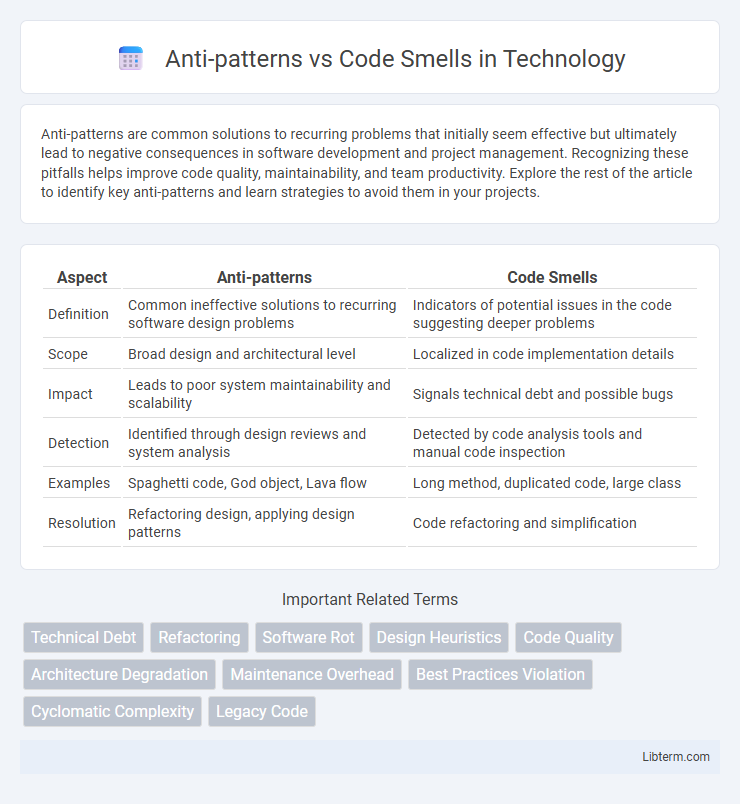Anti-patterns are common solutions to recurring problems that initially seem effective but ultimately lead to negative consequences in software development and project management. Recognizing these pitfalls helps improve code quality, maintainability, and team productivity. Explore the rest of the article to identify key anti-patterns and learn strategies to avoid them in your projects.
Table of Comparison
| Aspect | Anti-patterns | Code Smells |
|---|---|---|
| Definition | Common ineffective solutions to recurring software design problems | Indicators of potential issues in the code suggesting deeper problems |
| Scope | Broad design and architectural level | Localized in code implementation details |
| Impact | Leads to poor system maintainability and scalability | Signals technical debt and possible bugs |
| Detection | Identified through design reviews and system analysis | Detected by code analysis tools and manual code inspection |
| Examples | Spaghetti code, God object, Lava flow | Long method, duplicated code, large class |
| Resolution | Refactoring design, applying design patterns | Code refactoring and simplification |
Introduction to Anti-Patterns and Code Smells
Anti-patterns and code smells both indicate problematic software design but differ in scope and impact. Code smells are subtle indicators of deeper issues in code structure that may not cause immediate errors but suggest poor maintainability or scalability. Anti-patterns represent common, recurring design mistakes that lead to significant architectural problems and tightly coupled, fragile systems.
Defining Anti-Patterns
Anti-patterns are common solutions to recurring problems in software design that are ineffective and counterproductive, often leading to poor maintainability and scalability. Unlike code smells, which are subtle indicators or symptoms of deeper issues in the codebase, anti-patterns represent entire approaches or methods that should be avoided due to their long-term negative impact. Recognizing and refactoring anti-patterns such as "God Object," "Spaghetti Code," or "Golden Hammer" is crucial for improving code quality and fostering sustainable development practices.
What Are Code Smells?
Code smells are subtle indicators within the codebase that suggest potential issues affecting readability, maintainability, or scalability, without necessarily being outright errors or bugs. Common examples include duplicated code, long methods, and large classes, which often signal deeper underlying problems in design or implementation. Identifying code smells early enables developers to refactor and improve code quality before more serious problems arise.
Key Differences: Anti-Patterns vs Code Smells
Anti-patterns represent recurring design or architectural mistakes that hinder software maintainability and scalability, while code smells are more localized indicators of potential problems in the codebase, such as duplicated code or long methods. Anti-patterns often require significant refactoring or redesign to resolve, whereas code smells can typically be addressed with targeted refactoring techniques. Understanding these key differences helps developers prioritize technical debt management and improve overall code quality effectively.
Common Types of Code Smells
Common types of code smells include duplicated code, which leads to maintenance challenges, long methods that reduce readability and increase complexity, and large classes that violate the single responsibility principle. Other frequent code smells are feature envy, where a method overly relies on another class's data, and shotgun surgery, where small changes require modifications in multiple places. Recognizing these smells early helps developers refactor code efficiently and avoid more severe anti-patterns.
Frequent Anti-Patterns in Software Development
Frequent anti-patterns in software development include Spaghetti Code, God Object, and Golden Hammer, each leading to reduced code maintainability and scalability. These anti-patterns manifest as poor practice habits that degrade software architecture and complicate debugging efforts. Identifying and refactoring such anti-patterns early improves code quality and aligns development with best practices.
Identifying Code Smells in Projects
Code smells are subtle indicators of potential issues in a codebase that may not immediately cause errors but suggest deeper problems affecting maintainability and readability. Identifying code smells in projects involves examining patterns such as duplicated code, long methods, large classes, and excessive coupling, which often degrade software quality. Detection tools and code reviews help uncover these symptoms early, guiding refactoring efforts before anti-patterns--more entrenched design flaws--take hold.
Recognizing Anti-Patterns in Practice
Recognizing anti-patterns in practice requires identifying recurring development mistakes that lead to inefficient, fragile, or hard-to-maintain code structures distinct from simple code smells. Key anti-patterns such as "God Object," "Spaghetti Code," and "Golden Hammer" reveal deeper architectural flaws compared to superficial code smells like duplicated code or long methods. Effective detection involves analyzing system behavior, understanding design context, and applying software engineering principles to mitigate long-term technical debt.
Mitigation Strategies for Code Smells and Anti-Patterns
Mitigation strategies for code smells involve targeted refactoring techniques such as extracting methods, renaming variables for clarity, and simplifying complex conditional statements to improve code readability and maintainability. Addressing anti-patterns requires a comprehensive approach, including redesigning system architecture, enforcing coding standards, and incorporating automated testing to prevent recurring issues. Continuous code reviews and static analysis tools play a crucial role in early detection and resolution of both code smells and anti-patterns, reducing technical debt and enhancing software quality.
Best Practices for Clean and Maintainable Code
Anti-patterns represent common but ineffective solutions in software development that lead to poor design, while code smells are subtle indicators pointing to potential issues in code quality. Adhering to best practices such as refactoring, adhering to the Single Responsibility Principle, and ensuring clear, concise naming conventions can effectively address both anti-patterns and code smells. Implementing automated code reviews and continuous integration helps maintain clean, maintainable code by detecting and mitigating these problems early in the development lifecycle.
Anti-patterns Infographic

 libterm.com
libterm.com